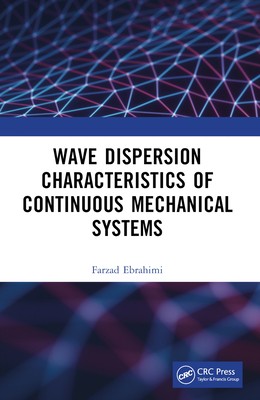
- We will send in 10–14 business days.
- Author: Farzad Ebrahimi
- Publisher: CRC Press
- ISBN-10: 1032218347
- ISBN-13: 9781032218342
- Format: 15.2 x 22.9 x 3 cm, hardcover
- Language: English
- SAVE -10% with code: EXTRA
Wave Dispersion Characteristics of Continuous Mechanical Systems (e-book) (used book) | bookbook.eu
Reviews
Description
This book provides a mechanical engineering-based analysis of wave dispersion response in various structures created from different materials. Looking at materials including strengthened nanocomposites, functionally graded materials, metal foams and anisotropic materials, it uses analytical solution methods to solve typical problems.
Nanocomposites are a novel type of composite materials, fabricated through dispersing nanosized reinforcements in a matrix to combine the material properties of the matrix with the improved properties of nanosize elements. This improves the elastic properties, providing high frequency ranges and buckling limits, leading industries such as the automobile industry to implement nanocomposites in various materials used in the production process. This book enables readers to learn about the theory and practical applications of this rapidly evolving field. Nanocomposites use materials such as a matrix reinforced with carbon-based components such as carbon fiber, carbon nanotubes, graphene platelets and graphene oxide powders. The physical and chemical properties of these nanocomposites are computed with the help of homogenization techniques, developed in the framework of a micromechanics approach. Practically minded, the book investigates the impact of employing various nanofillers, and demonstrating how this augments stiffness within the nanocomposite. Topics covered include agglomeration and waviness of nanofillers, porosity, elastic mediums, fluid flow, and the impact of the thermal environment on a propagated wave. Using mathematical formulations to solve wave dispersion characteristics of structures including beams, plates and shells, the book obtains equations of structures using first and higher-order shear deformation theories.
The book will be of interest to professional engineers working in material and mechanical engineering, nanocomposites, nanofillers and micromechanics. It will also be of interest to students in these fields.
EXTRA 10 % discount with code: EXTRA
The promotion ends in 18d.22:16:19
The discount code is valid when purchasing from 10 €. Discounts do not stack.
- Author: Farzad Ebrahimi
- Publisher: CRC Press
- ISBN-10: 1032218347
- ISBN-13: 9781032218342
- Format: 15.2 x 22.9 x 3 cm, hardcover
- Language: English English
This book provides a mechanical engineering-based analysis of wave dispersion response in various structures created from different materials. Looking at materials including strengthened nanocomposites, functionally graded materials, metal foams and anisotropic materials, it uses analytical solution methods to solve typical problems.
Nanocomposites are a novel type of composite materials, fabricated through dispersing nanosized reinforcements in a matrix to combine the material properties of the matrix with the improved properties of nanosize elements. This improves the elastic properties, providing high frequency ranges and buckling limits, leading industries such as the automobile industry to implement nanocomposites in various materials used in the production process. This book enables readers to learn about the theory and practical applications of this rapidly evolving field. Nanocomposites use materials such as a matrix reinforced with carbon-based components such as carbon fiber, carbon nanotubes, graphene platelets and graphene oxide powders. The physical and chemical properties of these nanocomposites are computed with the help of homogenization techniques, developed in the framework of a micromechanics approach. Practically minded, the book investigates the impact of employing various nanofillers, and demonstrating how this augments stiffness within the nanocomposite. Topics covered include agglomeration and waviness of nanofillers, porosity, elastic mediums, fluid flow, and the impact of the thermal environment on a propagated wave. Using mathematical formulations to solve wave dispersion characteristics of structures including beams, plates and shells, the book obtains equations of structures using first and higher-order shear deformation theories.
The book will be of interest to professional engineers working in material and mechanical engineering, nanocomposites, nanofillers and micromechanics. It will also be of interest to students in these fields.


Reviews